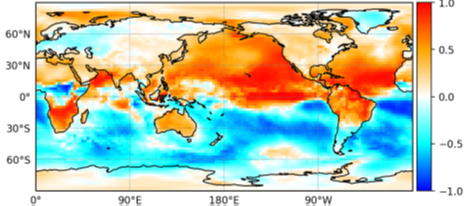Thesis with key insights on climate change is defended in the C&AP Ph.D. program
Jun 17, 2019
Dario Zappalà defended his work last April on air temperature dynamics and climate change under the direction of Cristina Masoller in the Nonlinear Dynamics, Nonlinear Optics and Lasers group.
Hilbert analysis of air temperature dynamics is the title of the thesis defended in ESEIAAT in the Computational and Applied Physics Ph.D program by Dario Zappala in front of a jury formed by Emilio Hernandez Garcia (CSIC & Univ. Illes Balears), Alvaro Corral from the center of mathematical research (CRM) and Ramon Herrero from our department.
The thesis is focused on the dynamics of atmospheric temperature and analyses time series of surface air temperature using the Hilbert transform. This allows the authors to characterise the dynamics of temperature with time series of instantaneous amplitude, phase and frequency. Using these series as the basis, meaningful information about global patterns of temperature dynamics is extracted and the dynamics of instantaneous frequency and phase in three geographical sites is studied. The results reflects the main features of different climates, in particular the difference between the tropical and the extratropical climate.
Then, the work proposes the use of the Hilbert time series to quantify inter-decadal changes in temperature dynamics (specifically, in the last 35 years) finding high changes in amplitude in the Arctic and Amazonia, which are interpreted respectively as due to ice melting and precipitation decrease. It also uncovers frequency changes in the Pacific Ocean, which suggests a shift towards north and a widening of the atmospheric convection pattern known as the intertropical convergence zone. Finally, Dario, together with other authors, analyse correlations between the phase, amplitude and frequency dynamics in different regions. They analyze phase synchronisation in three areas: the northern extratropics, the southern extratropics and the tropics, with attention to statistical correlations with the rest of the world, using the different Hilbert time series. The thesis defends that these correlations capture large-scale climatic patterns, such as El Niño-Southern Oscillation and Rossby waves.
The results of this thesis, given its relevance for the dynamics of the climate system which play a crucial role in the sustainability of life on Earth, has already reached larger audiences since La Vanguardia, El periodico or Antena 3 have published reports about its findings.
We congratulate the new doctor effusively.

Share: